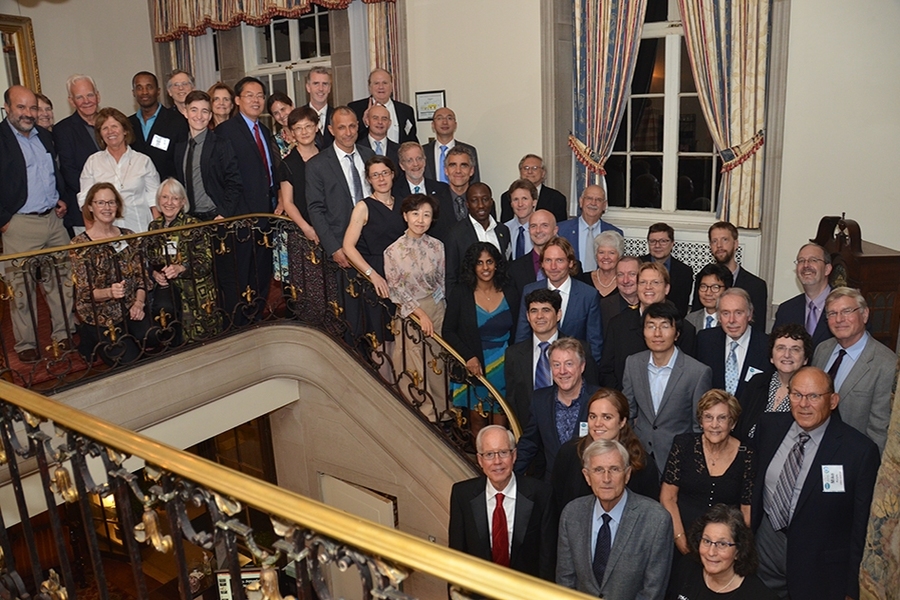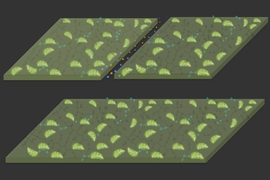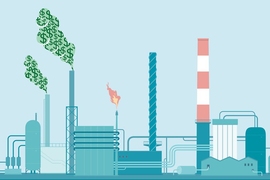Measuring the greenhouse and ozone-depleting gas composition of the Earth’s atmosphere continuously for the past 40 years through a global network of sophisticated monitoring stations, the Advanced Global Atmospheric Gases Experiment (AGAGE) has racked up numerous notable achievements.
Among other things, the network’s measurements have helped estimate the lifetimes of ozone-depleting and greenhouse gases in the atmosphere; monitor and pinpoint sources of emissions of chemicals banned by international agreements such as the Montreal Protocol, which outlawed the use of chlorofluorocarbons (CFCs); determine concentrations of the atmosphere’s major cleansing agent, the hydroxyl radical (OH); and provide data to inform international policy discussions concerning atmospheric greenhouse gas emissions.
To celebrate these and other achievements aimed at improving our understanding of key global chemical and climatic phenomena, nearly 40 AGAGE scientists, collaborators, and invited guests from research institutions around the world (many representing dozens more researchers at their home institutions) gathered at a 40th anniversary conference earlier this month at Endicott House. Participants discussed the network’s evolution, impacts, and future.
History
Founded in 1978, AGAGE has also been known as the Global Atmospheric Gases Experiment (GAGE) and the Atmospheric Lifetime Experiment (ALE). Co-founder and leader Ronald Prinn has helped ALE/GAGE/AGAGE merge theory with experimental procedures to measure atmospheric concentrations and thus lifetimes of target gases.
“From the beginning, AGAGE has been a close collaboration between experiment and theory, each informing the other to achieve the siting, frequency, precision and accuracy of measurements needed to answer the scientific questions before us,” said Prinn, an expert in atmospheric chemistry who is director of MIT’s Center for Global Change Science and a professor in the Department of Earth, Atmospheric and Planetary Sciences (EAPS).
When the network started, those questions included: how frequently to take measurements, where to put measuring stations, how precise to make the measurements, and which gases to measure and which instruments to deploy.
In order to detect and measure the atmospheric concentrations and lifetimes of ozone-depleting and greenhouse gases (GHGs), scientists built measurement instruments and developed computer software to interpret the data. Critical to measuring atmospheric pollutants was to deploy instruments onsite that could take measurements at least four times a day, rather than once a week, the typical rate of gas-measuring stations at the time.
“The goal was to measure ozone-depleting and greenhouse gases onsite at frequencies sufficient to identify both polluted and background air,” Prinn said.
Supported at first by a chemical industry keen on positioning itself to invent replacements for chemicals likely to be banned by international agreements, ALE’s initial goal was to determine the lifetimes of major ozone-depleting gases such as CFCs. The longer they last, the more that get destroyed only in the stratosphere; the shorter they last, the more they can be destroyed in the lower atmosphere before they can damage the ozone layer.
Within three years of deploying four measuring stations, ALE scientists determined that most ozone-depleting gases ended up in the stratosphere. (As it turned out, chemicals engineered to replace ozone-depleting gases were GHGs, known to warm the climate.) Subsequently, NASA, the lead federal agency for upper atmosphere research, became the main supporter of ALE, GAGE and AGAGE. In recent years, AGAGE has become truly international with 13 stations around the world, many of them receiving additional funding from the host nations.
In the 40 years since ALE’s founding, the network’s capabilities have grown significantly through more automation, instruments and stations; more powerful computers; and better computer models. The network first had four stations using gas chromatographs with electron capture detectors (GC-ECDs) measuring five gases four times a day, with sources and sinks inferred using very low-resolution 2-D model. Now there are 13 primary stations with a far more sophisticated set of instruments measuring well over 50 gases 20-40 times per day, with sources and sinks inferred using very high-resolution 3-D models and supercomputers. Today AGAGE data is often combined with NOAA surface data, and NASA and NOAA aircraft and satellite data, yielding a more comprehensive picture of atmospheric gases.
“I think our top accomplishment has been to measure this wide range of gases with precision, and do it in near-real time,” said Peter Simmonds, a visiting professor at the University of Bristol, who has served as an experimentalist throughout the network’s existence. Simmonds, who once built a portable gas chromatograph to measure CFCs, set up two of the first ALE monitoring stations in Ireland and Barbados.
“Our network is unique in that it provides estimates of global, national and city emissions of greenhouse and ozone depleting gases,” said Paul Fraser, an atmospheric chemist who established the network’s first Southern Hemisphere measurements of CFCs in the late-1970s and today calculates emissions using data from the Southern Hemisphere Station in Tasmania. “It allows us to say, yes, we have emissions problems, and this is where they’re coming from. And that enables us to then specifically identify industries that might be involved and to help them in their efforts to reduce these emissions.”
That capability can be critical in ensuring compliance with international environmental agreements such as the Montreal Protocol, said Ray Weiss, a professor at the Scripps Institution of Oceanography at the University of California at San Diego, who has overseen experimental management since joining the network 10 years after its inception — improving station technology and instrumentation calibration, increasing automation of station operations and centralizing data processing over the years.
“The only way to make sure [environmental policies] are working is to quantify what’s actually going into the atmosphere, whether it’s gases that affect climate or the ozone layer,” Weiss said. “The important thing is to keep doing it. It’s not exciting, but it has to be done independently.”
Informing the ban on CFCs
“What an achievement you have had over 40 years of incredible data that allowed you to actually be part of the process that led to a change. You have literally changed the world,” said EAPS Professor Susan Solomon, the conference’s keynote speaker, who described herself as an avid follower of AGAGE’s work and user of its data. Solomon recounted how data on the lifetimes of CFCs informed her research — most notably her discovery of the mechanism behind the formation of the ozone hole above Antarctica, which led to the banning of CFCs through the Montreal Protocol.
Among other things, ALE network methodology and data led to the publication of a paper that was the first to estimate the lifetimes of CFCs, using a top-down analysis that deduced the information from measurements of concentrations of CFCs already in the atmosphere — rather than a time-consuming bottom-up approach that would have entailed evaluating an endless number of alternative processes that skeptics hypothesized would show that CFCs would dissipate long before they could damage the ozone layer. Subsequent papers based on 3-D models and ALE data, established the stratosphere, rather than the lower atmosphere, as the domain where CFCs disintegrate, putting them in prime position to deplete the ozone layer.)
“We have to thank this network for the fact that we didn’t have to go after this in a bottom-up way,” said Solomon. “It’s because of the fact that we could go out and measure the concentrations of these things [that we didn’t] have to fight that bottom-up battle.”
During the Q&A session following her talk, Solomon also noted the value of AGAGE measurements of the important non-carbon-dioxide (non-CO2) greenhouse gases assessed by the Intergovernmental Panel on Climate Change. “There’s plenty to do on [greenhouse] gases that can contribute to global warming,” she said. “Your climate research on [these] gases is incredibly important and will surely be an area of continued need.”
Next steps
AGAGE is now complementing this work with intensified efforts to measure concentrations of more and atmospheric greenhouse gases. As AGAGE expands to take more high-frequency measurements, it also seeks to add many more stations in order to determine country-level emissions with greater accuracy.
Such measurements will be needed to improve understanding of global and regional trends in GHG emissions, and to help verify national and regional compliance to climate action pledges made in the Paris Agreement.
“The Paris Agreement is so loosely written that conformity is unlikely,” Weiss observed. “Anomalies will occur in a lot of places and that will make what we do very important.”












